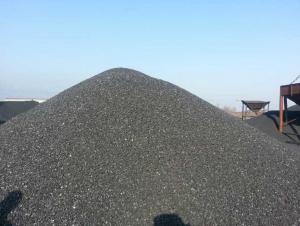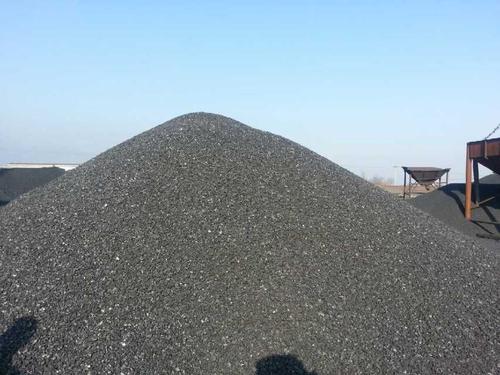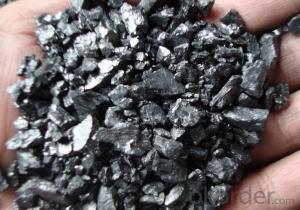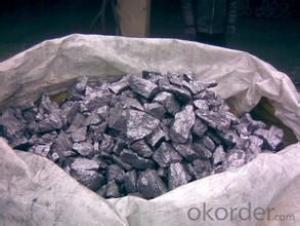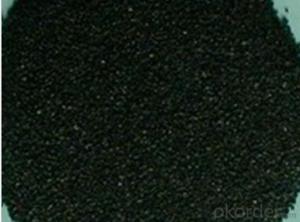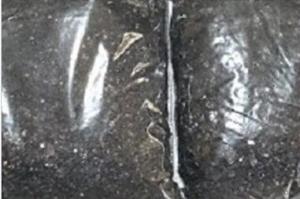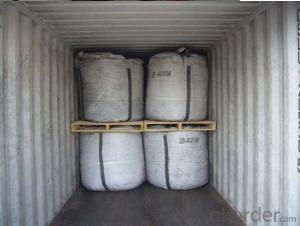Calcined Anthracite Coal With FC 90%-95% MIN
- Loading Port:
- Tianjin
- Payment Terms:
- TT or LC
- Min Order Qty:
- 0 m.t.
- Supply Capability:
- 20000 m.t./month
OKorder Service Pledge
OKorder Financial Service
You Might Also Like
Product Introduction:
Calcined anthracite Coal is also called Gas Calcined Anthracite Coal, Carbon Raiser,Recarburizer,etc.The main raw material of our Carbon Additive is Ningxia unique high quality Taixi anthracite, with characteristic of low ash and low sulfur. Carbon additive has two main usage, fuel and additive. When being used as the carbon additive of steel-smelting, and casting, the fixed carbon may achieve above 95%.
Usage:
1: Used as carbon additive to adjust the carbon in steelmaking, raising the quantity of steel scrap, and reduce the total cost
2: As carbon additive in foundry
3: to produce some carbon materials, such as carbon electrode, carbon electrode paste etc.
Packaging & Delivery
| Packaging Detail: | 25kgs/50kgs/1ton per bag or as buyer's request |
| Delivery Detail: | Within 20 days |
Specification
PARAMETER UNIT GUARANTEE VALUE | |||||
F.C.% | 95MIN | 94MIN | 93MIN | 92MIN | 90MIN |
ASH % | 4MAX | 5MAX | 6MAX | 7MAX | 8MAX |
V.M.% | 1 MAX | 1MAX | 1.5MAX | 1.5MAX | 1.5MAX |
SULFUR % | 0.5MAX | 0.5MAX | 0.5MAX | 0.5MAX | 0.5MAX |
MOISTURE % | 0.5MAX | 0.5MAX | 0.5MAX | 0.5MAX | 0.5MAX |
Size can be adjusted based on buyer's request.
Picture

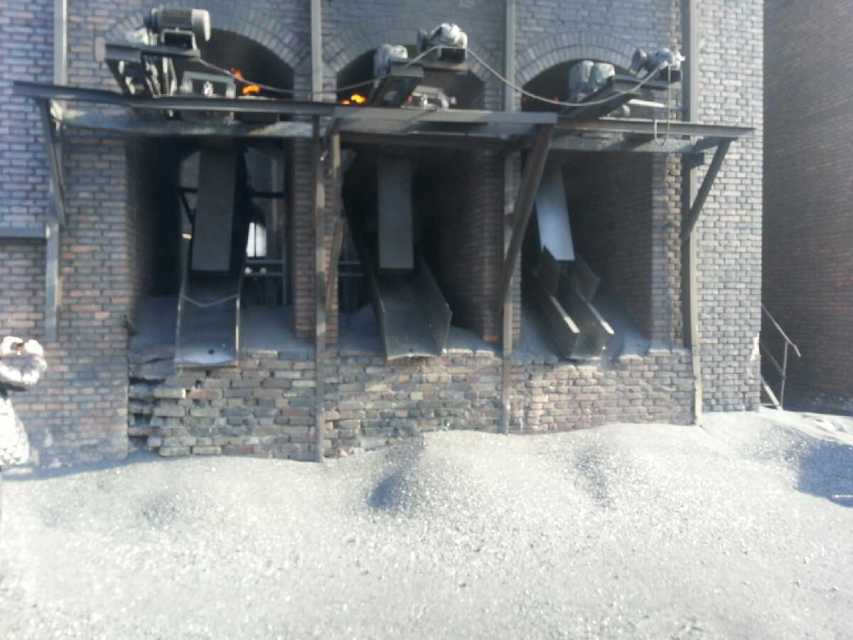
- Q: How does carbon impact the structure and function of ecosystems?
- Carbon, as a fundamental element, plays a crucial role in shaping the structure and function of ecosystems. It serves as a building block of life, found in all living organisms, and continuously cycles between the atmosphere, living organisms, and the Earth's surface. The impact of carbon on ecosystems is diverse, both directly and indirectly. To begin with, carbon is a vital component of organic matter, including plants, animals, and decomposing organic materials. It provides the necessary energy and nutrients for the growth and development of organisms. Through the process of photosynthesis, plants absorb carbon dioxide from the atmosphere and convert it into organic compounds, primarily carbohydrates. These compounds serve as a source of energy and building materials for other organisms, forming the basis of the food chain. As a result, carbon is essential for sustaining the productivity and biodiversity of organisms within ecosystems, as it contributes to their structure and functioning. Additionally, carbon influences the physical structure of ecosystems. In terrestrial ecosystems, carbon is stored in vegetation and soils, creating carbon sinks. Forests, for example, store significant amounts of carbon in their biomass and soils. This plays a crucial role in mitigating climate change by absorbing and sequestering carbon dioxide. However, the loss of these ecosystems, due to deforestation or degradation, can release large amounts of carbon back into the atmosphere. This contributes to the greenhouse effect and climate change. In marine ecosystems, carbon is stored in the form of dissolved inorganic carbon, which can affect ocean acidity. The increasing concentration of carbon dioxide in the atmosphere leads to ocean acidification, impacting the growth and survival of marine organisms, particularly those with calcium carbonate shells or skeletons, such as corals and mollusks. Furthermore, carbon influences the functioning of ecosystems through its role in nutrient cycling. Decomposition, the process of breaking down and recycling organic matter, is largely driven by microorganisms that respire carbon dioxide. This process releases essential nutrients, such as nitrogen, phosphorus, and sulfur, back into the soil, making them available for uptake by plants. Nutrient cycling is crucial for maintaining the productivity and nutrient balance within ecosystems. Changes in the availability of carbon can affect the rates of decomposition and nutrient cycling, which, in turn, impact the structure and functioning of ecosystems. In conclusion, carbon is a fundamental element that significantly impacts the structure and function of ecosystems. Its involvement in energy transfer, organic matter formation, nutrient cycling, and climate regulation makes it essential for the sustainability and functioning of all living organisms within an ecosystem. To ensure the health and resilience of ecosystems in the face of environmental changes, understanding and managing carbon dynamics is crucial.
- Q: How is carbon used in the production of carbon nanomaterials?
- Carbon is a crucial element in the production of carbon nanomaterials, as it serves as the building block for their unique structure and properties. There are various methods used to produce carbon nanomaterials, such as carbon nanotubes and graphene, all of which rely on the manipulation and organization of carbon atoms. One common method for producing carbon nanomaterials is through chemical vapor deposition (CVD). In this process, a carbon-containing gas, such as methane or ethylene, is introduced into a high-temperature furnace. Inside the furnace, the gas decomposes, releasing carbon atoms. These carbon atoms then reassemble and form nanoscale structures, such as carbon nanotubes or graphene, on a substrate or catalyst material. Another approach involves the vaporization of carbon-containing compounds, such as carbon black or graphite, using techniques like laser ablation or arc discharge. The vaporized carbon then condenses and solidifies into carbon nanomaterials with specific structures and properties. In both methods, the control of temperature, pressure, and the presence of catalysts or other additives allows for the precise manipulation of the carbon atoms, resulting in the desired carbon nanomaterials. The unique arrangement of carbon atoms in these materials, such as the hexagonal lattice structure of graphene or the cylindrical structure of carbon nanotubes, gives rise to their exceptional mechanical, electrical, and thermal properties. Overall, carbon plays a fundamental role in the production of carbon nanomaterials by providing the necessary atoms for their formation and determining their structure and properties. This knowledge and control over carbon's behavior at the atomic level enable scientists and engineers to develop nanomaterials with a wide range of applications, from electronics and energy storage to medicine and environmental remediation.
- Q: How does carbon impact the prevalence of tsunamis?
- The prevalence of tsunamis is not directly impacted by carbon dioxide. Tsunamis primarily occur due to undersea earthquakes, volcanic eruptions, or underwater landslides. These events release massive amounts of energy into the water, creating powerful waves that can travel across the ocean and cause devastating destruction upon reaching the coast. Although tsunamis are not directly caused by carbon dioxide emissions, there is a connection to climate change, which can indirectly influence the frequency and impact of these natural disasters. The increased levels of carbon dioxide and other greenhouse gases in the atmosphere contribute to global warming, resulting in the rise of sea levels. As the sea levels rise, coastal areas become more susceptible to the destructive force of tsunamis, as the waves can penetrate further inland. Additionally, climate change can also have an impact on the frequency and intensity of extreme weather events like hurricanes and tropical storms. These weather patterns can trigger underwater landslides or increase the likelihood of volcanic eruptions, both of which can lead to the occurrence of tsunamis. In conclusion, while carbon dioxide emissions do not directly cause tsunamis, they do play a role within the broader context of climate change. This indirect impact can result in rising sea levels and the potential for more frequent extreme weather events, ultimately affecting the prevalence and impact of tsunamis.
- Q: What is the role of carbon 60 in industry? Can it be interchanged with the chemical properties of carbon? What is the chemical structure of carbon 60?
- Used to strengthen metals; used as a new catalyst for storage of gases
- Q: We need to make a poster... Of the 27 essential elements of the human body, I am in charge of carbon! I haven't found it for a long time! Who can help me? Urgent!!!!!!Can you find something very specific? Thank you
- It is well known that the basic units of life, amino acids and nucleotides, are derived from carbon skeletons. First, a carbon chain, a chain of carbon bound together, evolved into proteins and nucleic acids; then evolved primitive single cells, evolved worms, fish, birds, animals, monkeys, orangutans, and even humans.
- Q: How does carbon contribute to the strength of composite materials?
- Carbon contributes to the strength of composite materials through its exceptional stiffness and high tensile strength properties. When carbon fibers are embedded in a matrix material, such as a polymer resin, they provide reinforcement and help distribute loads evenly throughout the composite. This reinforcement enhances the overall strength, durability, and resistance to deformation of the composite material, making it ideal for various applications in aerospace, automotive, and construction industries.
- Q: How does carbon impact the acidity of rainfall?
- The acidity of rainfall is influenced by carbon, which causes acid rain. Acid rain is formed when carbon dioxide (CO2) is released into the atmosphere and combines with water (H2O) to create carbonic acid (H2CO3). This natural reaction has been significantly amplified by human activities like burning fossil fuels and industrial processes, resulting in increased levels of carbon dioxide in the atmosphere. Once carbonic acid is formed, it can further react with other compounds in the air, such as sulfur dioxide (SO2) and nitrogen oxides (NOx), leading to the formation of stronger acids like sulfuric acid (H2SO4) and nitric acid (HNO3). These acids then dissolve in rainwater and produce acid rain. The presence of carbon in the atmosphere contributes to the overall acidity of rainfall. Acid rain has harmful effects on the environment, ecosystems, and human health. It causes damage to forests, lakes, and rivers, leading to the decline of fish populations and destruction of habitats. Additionally, acid rain corrodes buildings and monuments, erodes metals, and harms crops. The impact of carbon on the acidity of rainfall emphasizes the significance of reducing carbon emissions and addressing climate change. By transitioning to cleaner energy sources, implementing sustainable practices, and reducing our carbon footprint, we can help mitigate the acidity of rainfall and minimize the negative consequences associated with acid rain.
- Q: What are the consequences of increased carbon emissions on global food security?
- Increased carbon emissions have significant consequences on global food security. One of the most immediate impacts is the alteration of weather patterns and increased frequency of extreme weather events such as droughts, floods, and heatwaves. These events can lead to crop failures, reduced agricultural productivity, and loss of livestock, ultimately resulting in food shortages and price volatility. Carbon emissions also contribute to climate change, leading to long-term shifts in temperature and precipitation patterns. Higher temperatures can accelerate the growth and reproduction rates of pests and diseases, which can devastate crops and livestock. Additionally, changes in rainfall patterns can disrupt the timing and quantity of water available for irrigation, further reducing agricultural productivity. Furthermore, carbon emissions contribute to the acidification of oceans, which negatively affects marine ecosystems and the livelihoods of communities dependent on fishing and aquaculture. This can lead to a decline in fish stocks, threatening the availability of a vital source of protein and nutrition for millions of people. Another consequence of increased carbon emissions is the loss of biodiversity. Climate change can disrupt ecosystems, leading to the extinction or migration of plant and animal species. This loss of biodiversity reduces the resilience and adaptability of agricultural systems, making them more vulnerable to pests, diseases, and environmental stresses. Ultimately, the consequences of increased carbon emissions on global food security are far-reaching and complex. They include decreased agricultural productivity, increased food prices, food shortages, and reduced access to nutritious food. Addressing carbon emissions and mitigating climate change is crucial to ensure a sustainable and secure global food system for future generations.
- Q: Which carbon content is larger, steel or pig iron?
- The carbon content of pig iron is large. The carbon content of pig iron is usually 2.5%--4%, and the carbon content of steel is 0.05% - 2%
- Q: The relative molecular mass was between 120-150. The testThe organic matter M, which contains only carbon, hydrogen and oxygen, was measured by mass spectrometer. The relative molecular mass was between 120-150. The mass fraction of oxygen element measured by experiment is 48.48%, the ratio of hydrocarbon to mass is 15:2, and only COOH in M molecule is measured by infrared spectrometer. Then the M formula is?
- The mass fraction of oxygen element is 48.48%, the mass fraction of hydrocarbon is =51.52%, and the mass ratio is 15:2. The mass fraction of carbon is =51.52%x15/ (15+2) =45.46%, and the mass fraction of hydrogen is =51.52%x2/ (15+2) =6.06%The atomic number of C, H and O is higher than that of =45.46%/12:6.06%/1:48.48%/16=3.79:6.06:3.03Molecules contain only COOH, and oxygen atoms must be even numbers.Therefore, the number of atoms in C, H and O can be reduced to =5:8:4, which may be C5H8O4, and the relative molecular weight is 132
Send your message to us
Calcined Anthracite Coal With FC 90%-95% MIN
- Loading Port:
- Tianjin
- Payment Terms:
- TT or LC
- Min Order Qty:
- 0 m.t.
- Supply Capability:
- 20000 m.t./month
OKorder Service Pledge
OKorder Financial Service
Similar products
Hot products
Hot Searches
